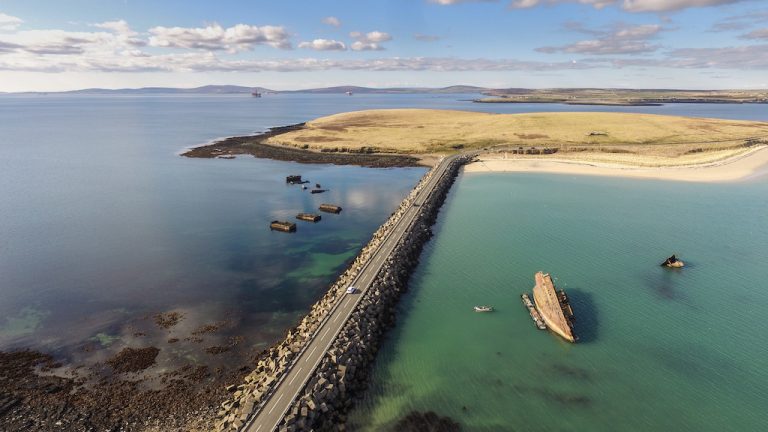Simon Creasey goes island hopping as he travels to the northernmost point of the British Isles on an adventure through Scotland.
We hadn’t planned to go to Scotland at all. My mate Bob and I were looking forward to a trip to Spain when various travel restrictions quashed that plan. We were wracking our brains for an alternative destination when I suggested the Orkney Islands and Shetland. I’ve always wanted to visit them and this seemed like a good opportunity to finally do it. Bob and I live in Wiltshire and Warwickshire respectively and we faced a journey of more than 700 miles before we even reached Orkney. Somewhat ironically, we would have covered a similar distance if we’d ridden to Northern Spain through France. Our first overnight stop was in Penrith, on the edge of Cumbria’s Lake District. From there, we made our way to Scotland, following the A9 through the Cairngorms National Park, enjoying the magnificent views it provided.
After overnighting in the small town of Dingwall, we made our way north-west to Ullapool on the shores of Loch Broom, where we joined the remote roads of the popular touring route, the NC500. We were blessed with perfect weather and the scenery was impressively wild. Much of the NC500 was windy single track and, even on motorcycles, it could be difficult to find room to pass an oncoming car or camper van. Thankfully, there were strategically positioned passing places dotted throughout.
We were heading towards Thurso, in the far north of Scotland, where we would catch a ferry. We arrived just before dusk as the weather started to deteriorate and the rain began to fall, so we quickly pitched up at Thurso Bay Caravan and Camping Park. The campsite was next to the sea and we had a distant view of Orkney as a low, dark landmass barely visible on the horizon.
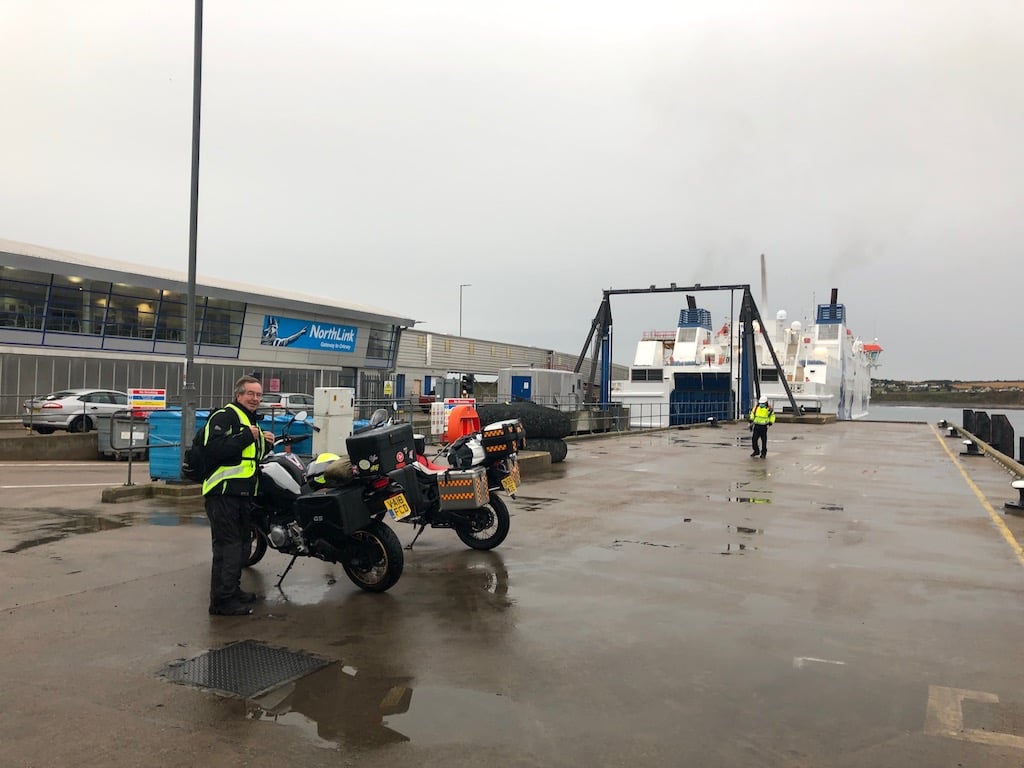
Arriving in Orkney
We left camp early the following morning to check in for the ferry at 8 am. Orkney is made up of more than 70 islands and islets, but only 20 are inhabited. With only a couple of days to explore before we needed to catch a ferry north to Shetland, we wanted to cover as much ground as we could. The majority of the attractions are beauty spots, or historical and Neolithic sites so I’m sure you could spend a week exploring if you had the time. We decided on a route around the islands that would take us past many of the attractions so that we could call in and look around if we wanted to.
Arriving at Orkney from the sea, the town of Stromness’ neat, tightly packed, hillside houses reminded me of a Lowry painting. We disembarked the ferry and headed straight for the Italian Chapel at Lamb Holm, Orkney’s most visited attraction. This ornately decorated Roman Catholic chapel was built by Italian prisoners of war during WWII. They’d been sent to the island to help construct barriers across Scarpa Flow to protect British Navy ships at anchor from German submarine attack. The Italians requested a proper place of worship and managed to persuade the camp commandant to allow them to build a chapel from two Nissen huts. The exceptional quality of the craftsmanship in this simple chapel was astounding. All the more so when you consider the difficulty obtaining the necessary materials for such a project in war time.
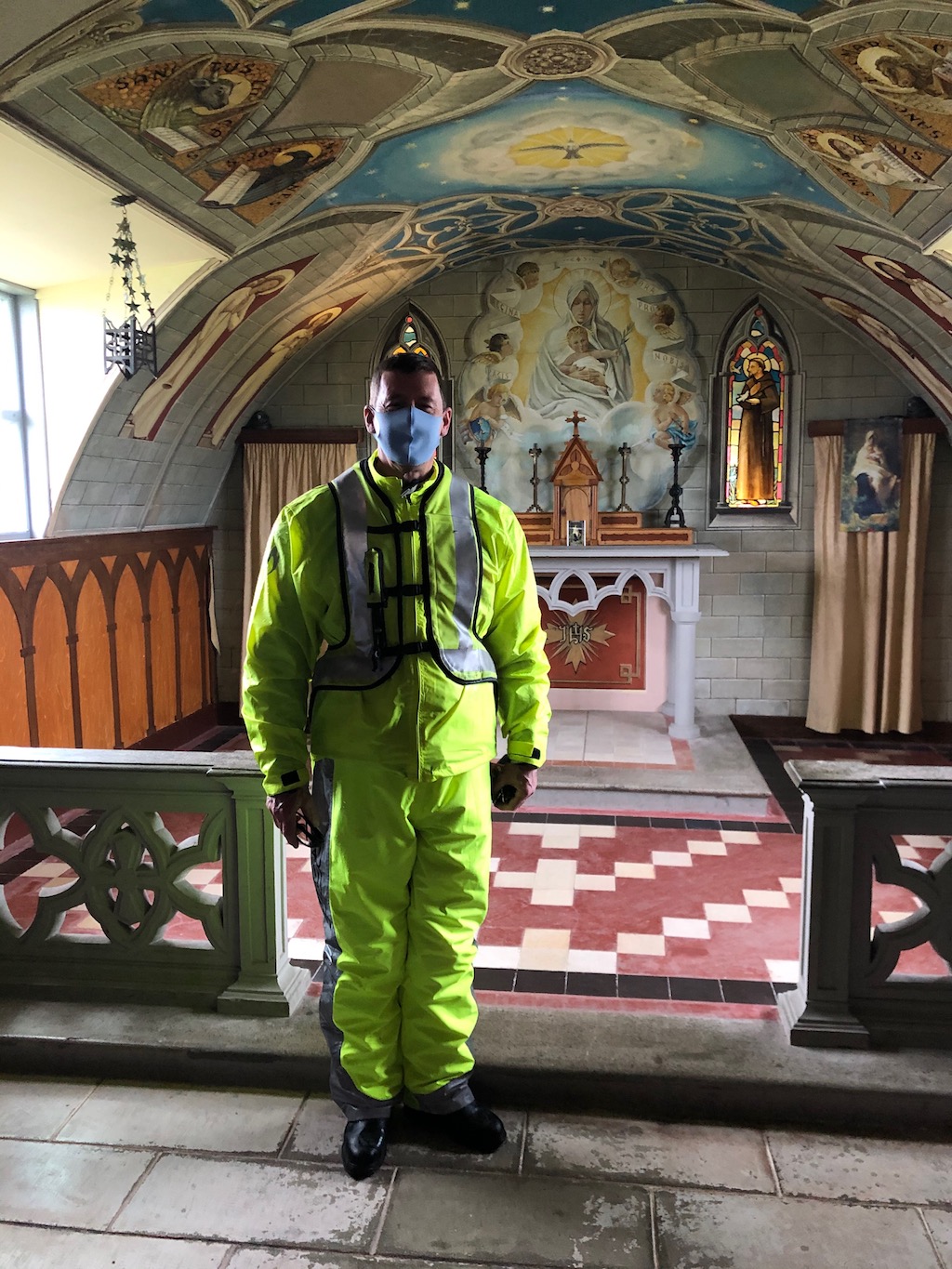
Souvenirs purchased, we then headed south across three submarine barriers to Burray village where we happened upon the Sands Hotel. Its exterior is unprepossessing, being built in the same simple style as many of the houses on Orkney from sandstone blocks. However, it was a gem. Its bar felt like being in the interior of an old wooden ship with large expanses of beautifully varnished mahogany. The staff were hospitable and the food exceptional. Had we turned around and ridden straight home, the Cullen Skink (a hearty soup) and prawn sandwiches alone were worth the ride to Orkney.
We pitched our tents at the Point of Ness Campsite overlooking the harbour entrance back at Stromness. At first sight, it seemed like an exposed and unwelcoming spot, but the jolly and very helpful campsite manageress (sporting purple hair and Dr Martens boots) was very hospitable and suggested that we locate ourselves next to a dry stone wall. This was an excellent suggestion as it gave us shelter from the gale-force wind and was also close to the toilets and showers.
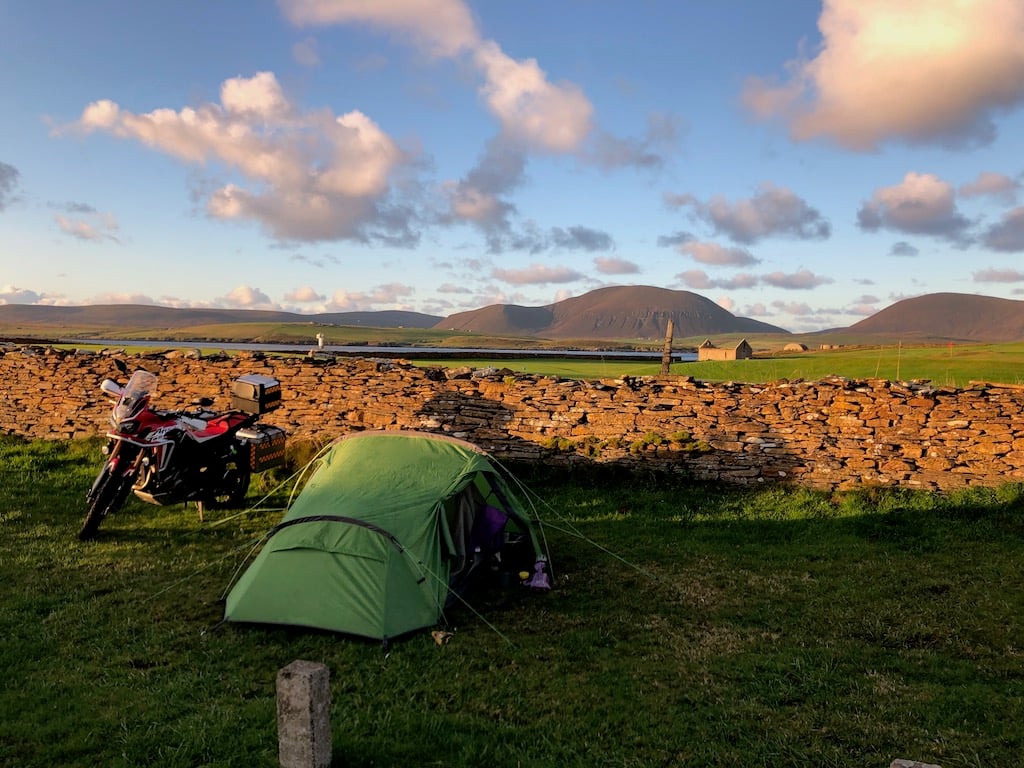
We were recommended the Ferry Inn in Stromness which was a 10-minute walk from the campsite along a historic paved street. I use the word historic advisedly as Stromness is the port where the Hudson Bay Company’s ships watered from 1670 to 1891, where Captain Cook’s vessels Resolution and Discovery passed through in 1780, and where Sir John Franklin’s ships Erebus and Terror visited ahead of an ill-fated Arctic exploration in 1845. The history here is palpable and uncluttered by the fog of modern events.
The food at the Ferry Inn was superb and the service excellent. We left contented and made our way back to camp. Putting our tents next to the wall proved to be a good move as there were strong winds and heavy rain during the night, and the wall protected our tents from the worst of it.
Exploring the islands
The daytime temperature on Orkney and Shetland during our stay in late September was around 11C. Imagine our surprise then to see a group of early morning swimmers. These ladies looked as comfortable going into the water as any summer holidaymaker on Bournemouth beach. Unfortunately, neither of us had swimming trunks, so much as we would have liked to have followed their example, we weren’t properly equipped.
Our first destination of the day was Burwick, a tiny hamlet and harbour on the southern tip of South Ronaldsay island. The journey there revealed Orkney is quite unspoilt. There was little traffic and we took in magnificent views across the rolling hills and sea to the nearby islands. Burwick turned out to be made up of a handful of buildings, so we turned around and headed towards our favourite place for lunch, The Sands Hotel. After our meal, Bob decided to go back to the campsite for a rest and get packed up for our departure to Shetland later that evening.
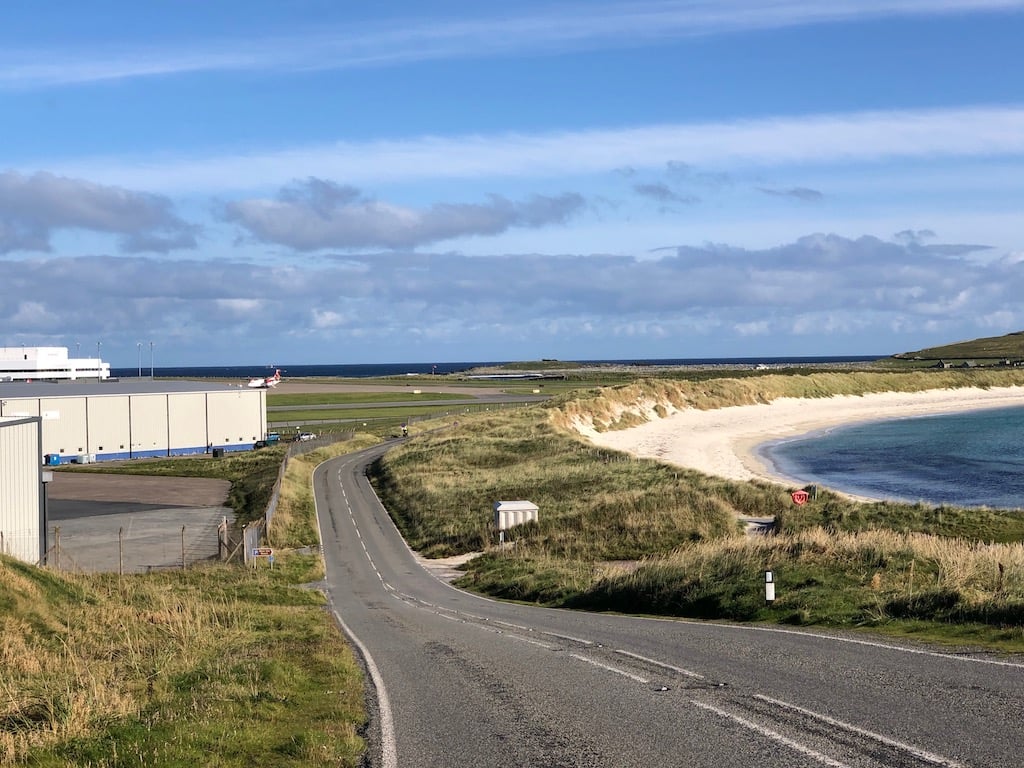
I headed for the town of Kirkwall to explore some local attractions including St Magnus’ Cathedral, the most northerly in Britain, as well as the impressive ruins of Bishop’s Palace and Earl’s Palace. I also couldn’t resist stopping off at the Scapa distillery on the way which is famous for its smooth and honeyed single malt. It was a pleasure to ride Orkney’s roads which are beautifully maintained. We saw very little traffic and what we did see was very biker friendly. The general feel of the Orkneys is not dissimilar to a blissfully tranquil Devon or Cornwall.
Welcome to Shetland
Bob had managed to negotiate an extension to our stay at the campsite, so we were able to strike camp late before making our way back to Kirkwall to catch the 11 pm ferry to Shetland. After an early meal in the Ferry Inn, we made our way from Stromness in pouring rain and strong wind. We arrived at Kirkwall in plenty of time for the ferry.
The NorthLink ferries are very comfortable and modern. The crew are very attentive to the needs of bikers and secured our bikes carefully. This subsequently proved to be a good thing as the ship rolled, pounded, and slammed its way through the waves during the eight-hour crossing from Orkney to Shetland. The following morning, we were relieved to find our bikes secure and in good order. We disembarked in Lerwick, and by 7.45 am the following morning, we were ready to go.
Our campsite on Shetland was located 16 miles away on the southern half of the island. It was situated on a terrace behind the village hall. The community had raised funds to extend the building by adding a kitchen and dining room to the edge of the hall, plus toilets and showers. This had enabled them to open a campsite which generated money for the village. We installed ourselves overlooking the sea next to a hedge for protection from the wind, with a magnificent view across the water to the east.
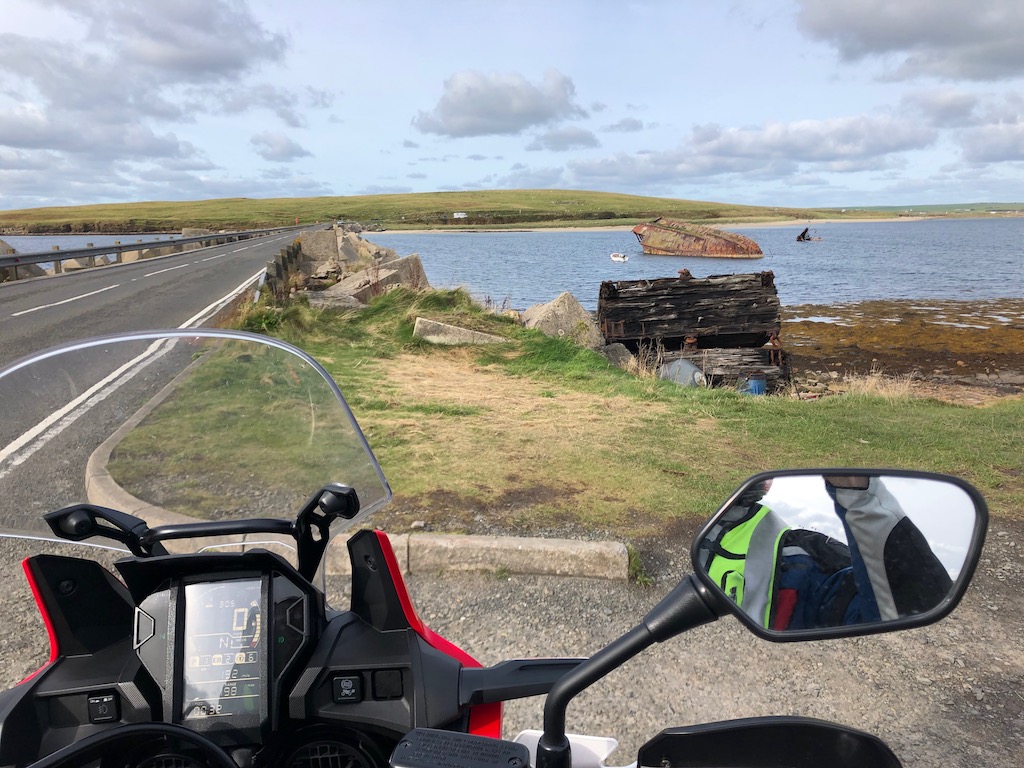
Having set ourselves up at the campsite, rested and with lunch eaten, we rode down to Sumburgh at the southern end of the island. This is the site of Sumburgh Head, Sumburgh Airport, and Jarlshof Prehistoric and Norse Settlement. Getting there involves crossing the end of one of the runways which is controlled by traffic lights. Sadly, Jarlshof was closed due to COVID-19 but the trip was worth it just for the view of Sumburgh Head and the magnificent beaches, that would not look out of place in the Caribbean.
We stopped off at the Post Office in the little village of Toab on the way back to the campsite. Its variety of stock would put many a village shop and minimart in England to shame, as would the Mainland’s mini market at Dunrossness, a little further back towards our camp in the direction of Levenwick. Certainly, don’t feel as if you need to bring all your supplies with you when visiting Shetland.
The northern lights, almost
The next day, we woke to a dramatic sunrise and discovered that the islands’ inhabitants had been treated to an aurora borealis display the night before, only about an hour after we went to bed. This is something that I have always wanted to see, so you can imagine how disappointed I was to have slept through it.
On local advice, we downloaded an app which tells you if there is likely to be aurora activity. Top Tip: download the app before you arrive so you don’t miss the northern lights like we did. We also discovered there is a Facebook page called Shetland Orca Sightings, which provides real-time updates on where the whales can be seen. This would have enabled us to hotfoot it to locations where we could have seen these magnificent creatures in their natural environment. Sadly, we weren’t on Shetland for long enough to be able to make use of this but I certainly recommend taking a look if you travel here yourself.
For our second day on Shetland, we decided to make our way up to the north and then catch the ferries to the islands of Yell and Unst. The northernmost point on Unst is at the same latitude as the southern tip of Greenland and Anchorage, Alaska, so this seemed like the crowning achievement of our trip. The journey would require catching two ferries, which we hadn’t taken the trouble of researching in any detail. The ride to Toft, where the ferry departs to Ulsta on Yell is straightforward and the scenery is wild moorland covered in rough grass and heather. Communities are few and far between and the houses in them are widely spaced. We were able to buy tickets on board the ferry at Toft. Make sure you take the right money, as there is a policy of giving no change. The ferry crossing to Yell took around 40 minutes, and was thankfully smooth.
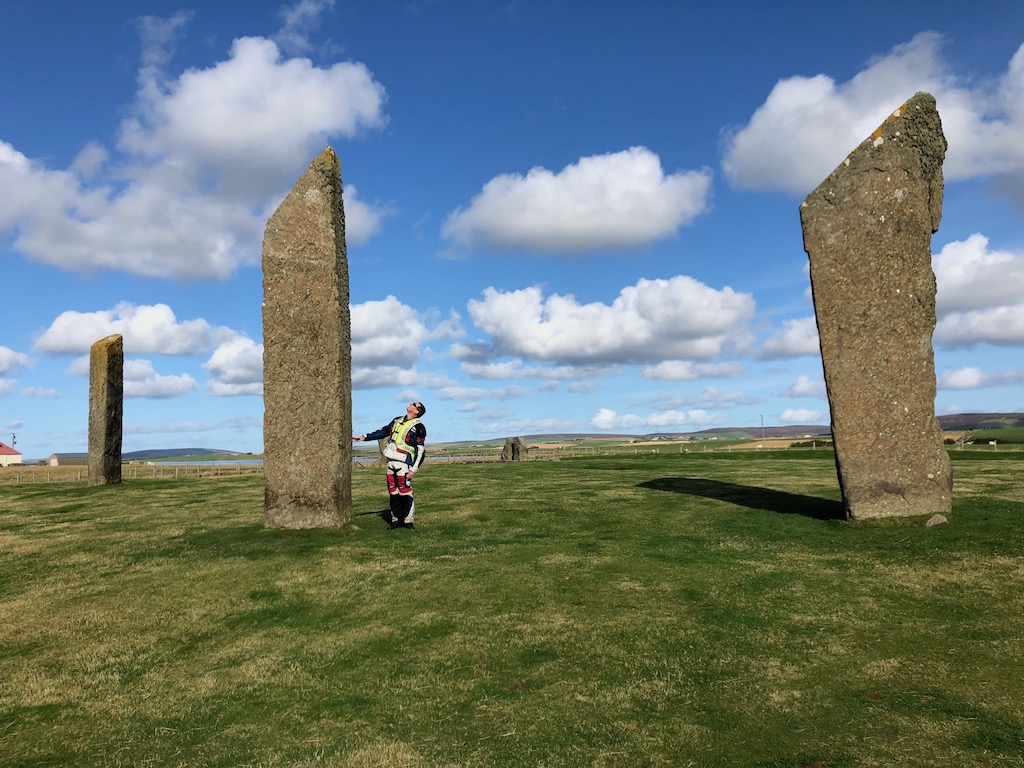
Having landed at Ulsta, we rode to Gutcher, via West Sandwick, on the north of Yell, a journey of about 25 minutes. Then we caught a second ferry to Belmont on Unst. The ferry was small and the waves seemed to be larger than our previous crossing, so it took some effort to keep our bikes upright on the way.
Once we made it to the island of Unst, we headed to Haroldswick, a small village on the edge of a beautiful bay. The village is home to the Unst Boat Haven which houses a historical collection of local fishing boats that have been used to catch herring around the Shetland Isles for hundreds of years. Sadly, it was closed but it would otherwise have been fascinating to visit. Haroldswick is also the site of the Remote Radar Head Saxa Vord, a Royal Air Force radar station. It was closed in 2006 but reopened in July 2019. It holds the unofficial British record for wind speed, which in 1992 was recorded at an incredible 197 mph just before the measuring equipment blew away!
The end of the road
From Haroldswick, we made our way two miles north to Norwick. This is the northernmost settlement in the British Isles. It’s a tiny place but the scenery is magnificent and there was a sense of achievement to be felt at having travelled this far north. From Norwick, we made our way back to Haroldswick where we stopped off to look at a superb replica Viking Long House and longboat called the Skidbladner.
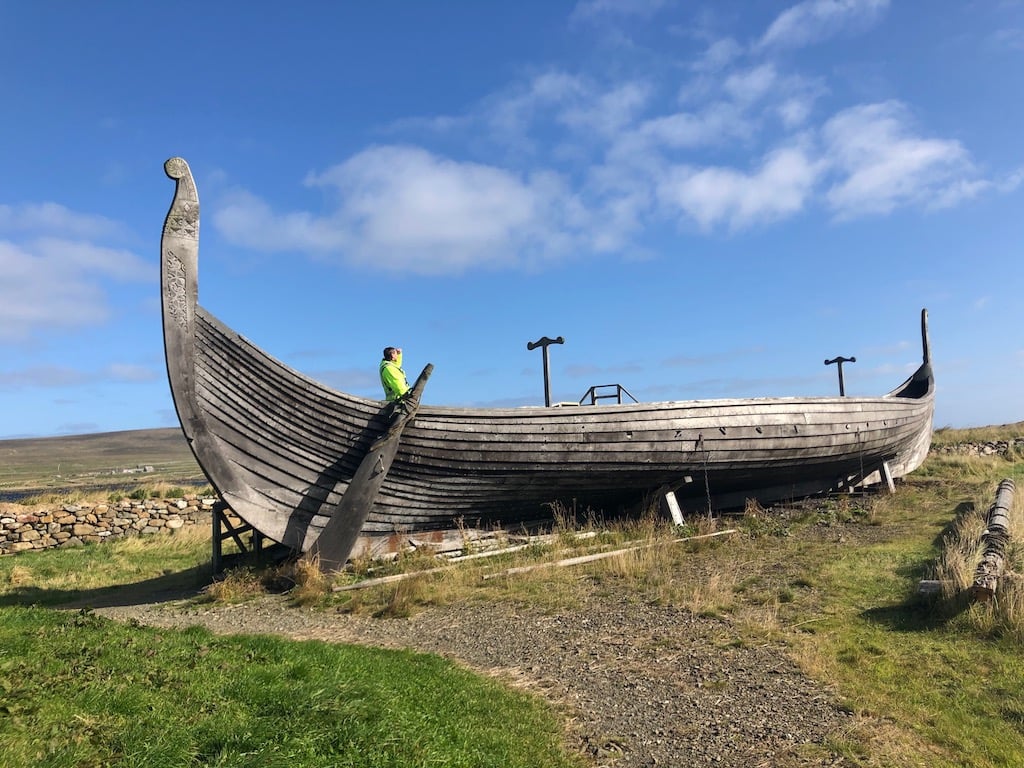
At this point, Bob was keen to get back to the campsite and left me to continue exploring. Having taken the ferry back to Yell, I rode the eastern side of the island via Otterswick and Burravoe. This decision was rewarded with stunning scenery. I was very much taken with the remoteness of Shetland. Much of the island is hilly and covered in peaty moorland, there are very few trees, and the A-roads generally consist of long straight stretches with picturesque views. They are also beautifully maintained and, outside the main city of Lerwick, they were almost deserted. We only had time to scratch the surface but there is also an abundance of wildlife to discover and there are numerous historical and archaeological sites. It is certainly worth a return visit.
Back at the campsite again, we enjoyed an evening meal cooked in the kitchen and relaxed over a few beers while chatting. The following day was our last on Shetland. We were both pretty exhausted by our trip, so we decided to take it easy. I was keen to buy a Shetland jumper and as luck would have it, there were two places near to the campsite. The first had been visited by the Queen and Prince Philip in 1969.
I usually find the last day of a bike trip is an anti-climax as I start to think about going home and back to work, and this was no exception. In the late afternoon, we said our farewells at the campsite and set off for Lerwick to catch the ferry to Aberdeen in mainland Scotland. With a gentle following breeze, we enjoyed a peacefully calm overnight crossing that allowed me to reflect on what had been a sensational journey.
We had travelled to the northernmost part of the UK on a level with the southern tip of Greenland, ridden one of the most spectacular parts of the NC500 between Scourie and Thurso, we’d visited Orkney and Shetland, seen magnificent Neolithic ruins and returned safely home. We may not have planned to ride to Scotland, but I’m very glad we did.


